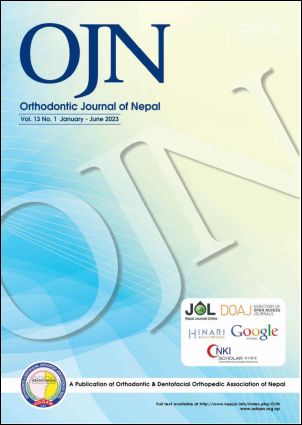A Correlative Study to Assess the Relationship among Ameloglyphics, Cheiloscopy, Rugoscopy in Skeletal and Dental Malocclusions
DOI:
https://doi.org/10.3126/ojn.v13i1.52144Keywords:
Ameloglyphics, Cheiloscopy, Dental malocclusion, Rugoscopy, Skeletal malocclusionAbstract
Introduction: Benefits of preventive and interceptive orthodontic procedures can be availed by early prediction of malocclusion. Early diagnosis is achievable when parameters having similar embryological origin and development period, similar to that of the craniofacial structures are identified and studied. Few such parameters are the enamel rod end patterns, lip prints, and palatal rugae patterns. The intent of this study was to assess the correlation between ameloglyphics, cheiloscopy, rugoscopy and skeletal and dental malocclusions.
Materials and Method: A cross-sectional study with one hundred subjects were classified into 3 groups based on cephalometric analysis into skeletal class I, class II and class III malocclusion and were further divided into 4 dental malocclusion groups namely class I, class II division 1, class II division 2 and class III based on the Angle's classification of malocclusion. Ameloglyphics patterns, lip prints and palatal rugae patterns were recorded for each subject and statistically analyzed with chi-square test and Spearman correlation test.
Result: Class I malocclusion subjects revealed a predominant curve palatal rugae pattern, type II lip print pattern and wavybranched ameloglyphics patterns were observed with statistically significant association. In class II malocclusion, the predominant palatal rugae pattern observed was straight pattern, type I lip print pattern and linear branched ameloglyphics patterns were statistically significant. Subjects in class III malocclusion group were associated significantly with the annular pattern of palatal rugae, type I lip print pattern, and stem pattern of ameloglyphics.
Conclusion: A curve rugae pattern in class I malocclusion, a straight pattern in class II malocclusion, and an annular pattern in class III malocclusion were observed. For the Lip Prints, a highly statistically significant association was observed between class I malocclusion and type II lip print pattern. Ameloglyphics, revealed a statistically significant association between wavy branched pattern and class I malocclusion, linear branched pattern and class II malocclusion and stem pattern with class III malocclusion.
Downloads
Downloads
Published
How to Cite
Issue
Section
License
Copyright (c) 2023 Orthodontic & Dentofacial Orthopedic Association of Nepal

This work is licensed under a Creative Commons Attribution 4.0 International License.
Copyright © held by Orthodontic & Dentofacial Orthopedic Association of Nepal
- Copyright on any research article is transferred in full to the Orthodontic & Dentofacial Orthopedic Association of Nepal upon publication in the journal. The copyright transfer includes the right to reproduce and distribute the article in any form of reproduction (printing, electronic media or any other form).
- Articles in the Orthodontic Journal of Nepal are Open Access articles published under the Creative Commons CC BY License (https://creativecommons.org/licenses/by/4.0/)
- This license permits use, distribution and reproduction in any medium, provided the original work is properly cited.




